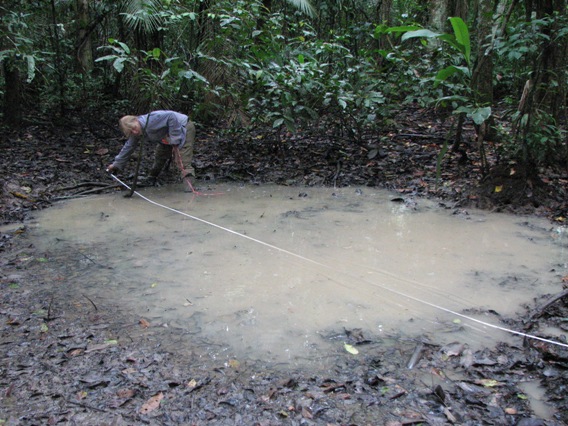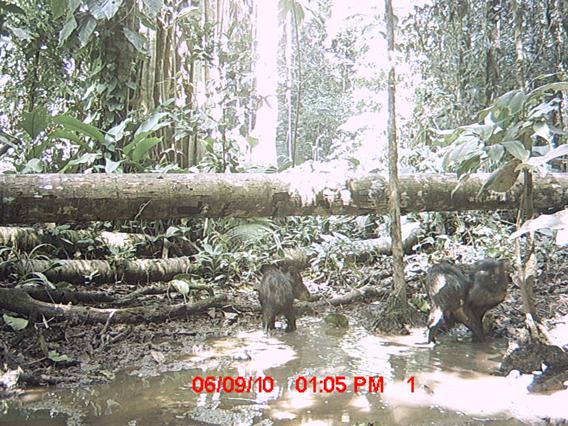When people think of the Amazon rainforest, they likely think of roaring jaguars, jumping monkeys, marching ants, and squeezing anacondas. The humble peccary would hardly be among the first animals to cross their mind, if they even know such pig-like animals exists! Yet new research on the peccary is proving just how vital these species are to the world’s greatest rainforest. As seed dispersers and seed destroyers, engineers of freshwater habitats and forest gaps, peccaries play an immense, long overlooked, role in the rainforest.
“Peccaries have the highest density and biomass of any Neotropical mammal species. Obviously these fellows have quite an appetite for almost anything, but primarily they consume fruits and seeds. Their specialized jaws allow them to crush very hard seeds. The cracking sounds can be heard through the thick vegetation long before we could see them. As peccary herds bulldoze through the leaf litter in search for insects, frogs, seeds, and fruits, they destroy (i.e. snap and trample) many seedlings and saplings, sometimes leaving only the bare ground behind,” Harald Beck, assistant professor at Towson University in Maryland, told mongabay.com in an interview. While such a description makes peccaries sound wholly destructive, Beck has identified that the species are closely linked to the survival of a wide-variety of tropical species from frogs to insects to plants. Beck says that his research shows that peccaries are ‘ecosystem engineers’, like more widely known species such as beavers.
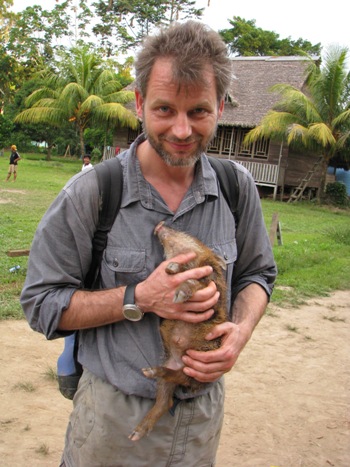 Dr. Harald Beck with a baby white-lipped peccary. Photo courtesy of Harald Beck. |
“In a nutshell, ecosystem engineers are species that physically create or modify existing environments, thereby changing the availability of resources for other species. […] Everybody knows at least one species that functions as ecosystem engineer: us—we, humans, are the ‘master’ in changing the environment. Every time a tropical rainforest is converted into a highway, we can see the immediate negative effects on species abundance and diversity. Classic examples of ecosystem engineers are beavers and corals.”
Much in the way that beaver dams shape an environment by providing new space for some animals, Beck has found evidence that peccary wallows provide a stable ecosystem for a wide variety of species. For example, these wallows, which are maintained for years—sometimes decades—by big peccary groups, contained higher density of tadpoles and frogs than natural ponds. Beck also found that the wallows were used by a wide-variety fauna: “numerous aquatic insects (e.g. beetles, dragonflies, mosquito larvae, and even a semi-aquatic cricket!), and spiders that glide across the water surface and hunt prey. We also found mussels, at least nine different species of fish, and two species of snakes. This year we installed motion-triggered cameras and captured bats skimming across the water surface.”
Beck and other researchers are in the process of deciphering just how many species are dependent on these wallows for survival. To date he has recorded ten frog species that depend on wallows either for breeding or foraging.
However, not only do peccaries create stable habitat for other fauna, they also play a major role in the structure of the forest. According to Beck, peccaries consume 250 different kinds of fruits, destroying 150 of these in the act of consumption.
“These are two world records and no other tropical mammal even comes close to these numbers.
But what does that mean in the big picture? Well! Clearly peccaries play an ecologically critical role as seed predator by being able to prey on small seeds (e.g. Ficus) to very hard seeds (e.g. Mauritius palm). Peccaries prevent common plant species from taking over and outcompeting rare species,” Beck says. By also spreading 50 different types of seeds, peccaries are thought to “play critical non-redundant roles (no other species could substitute their roles) as seed predators and dispersers, meaning that in forests where peccaries have become extinct, the plant species composition changed dramatically.”
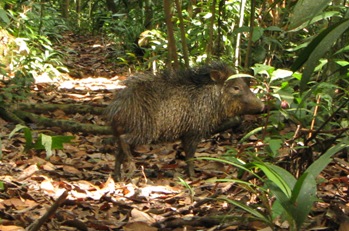 A collared peccary. Photo courtesy of Harald Beck. |
Of all the species in the Amazon, none is probably hunted so widely and so vehemently as the peccary. Add this to the ongoing problem of deforestation and peccaries have seen precipitous declines in their population and their range. As Beck points out, many Neotropical forests have already been emptied of peccary. Yet if the loss of peccaries sends such ripples through the forest ecosystem, why is their conservation not a priority?
Beck blames it on the politics of conservation, where a big cat like the jaguar is a much more attractive ‘keystone’ species of rainforest ecosystems than the lowly peccary. Yet, as Beck points out jaguars can survive in greater human-impacted habitats than white-lipped peccaries. In other words, if we only save jaguars we won’t save the less noble yet just as important peccary.
“I believe that we need to raise awareness of the ‘Peccary Dilemma’ by conveying ecological information much more effectively to the general public, policy-makers, and resource managers. We need to develop partnerships with the media, governmental agencies, NGOs, and private foundations to secure sufficient resources and develop realistic conservation strategies,” says Beck.
In a September 2010 interview with mongabay.com Harald Beck spoke about the importance of peccaries as ‘ecosystem engineers’, their role in seed dispersal and destruction, and the threats, including being long overlooked, to the conservation of abundant peccary populations.
Peccaries moving in rainforest. Video courtesy of Harald Beck.
INTERVIEW WITH HARALD BECK
Mongabay: What is your background?
Harald Beck: I grew up in south Germany, and stared my career as a nurse. I almost studied medicine, but my love for biology guided me into the right corner. In 1994, I received a master’s degree in Biology from the Friedrich Alexander Universität Erlangen-Nürnberg, Germany. Then, I jumped across the big pond, and in 2002 I earned a Ph.D. in tropical ecology from the University of Miami in Florida. After a two-year exciting post doc at Duke University, NC, with the world renowned tropical ecologist, Dr. John Terborgh, I accepted a position as assistant professor at Towson University in Maryland in 2005. Since then, I have been fortunate to introduce undergraduate and graduate students to the steamy Amazon rainforest.
Mongabay: How did you become interested in peccaries?
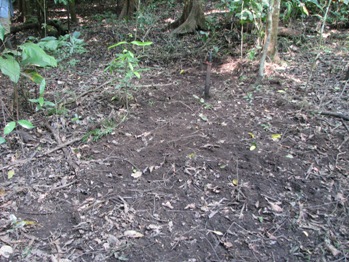 A rare sight in the rainforest: bare soil. This area was cleared not by man, but by an efficient troop of peccaries. Photo courtesy of Harald Beck. |
Harald Beck: For over 10 years, I have been privileged to conduct my research within one of the largest continuous rainforests in the world: the UNESCO World Heritage National Park Manu, which is located in the heart of the Peruvian Amazon. With no human disturbances and no species missing, we really can experience the nature and its biological interactions at its very best.
For my Ph.D. research, I was interested in understanding what factors influenced the species diversity of small mammals in the Amazon. While conducting research on the small guys it did not take long to encounter large herds of white-lipped peccaries. Sometimes hundreds of them were roaming through the understory (photo and video). When these animals moved, the whole understory was vibrating and it became apparent that they ruled the forest.
Peccaries have the highest density and biomass of any Neotropical mammal species. Obviously these fellows have quite an appetite for almost anything, but primarily they consume fruits and seeds. Their specialized jaws allow them to crush very hard seeds. The cracking sounds can be heard through the thick vegetation long before we could see them. As peccary herds bulldoze through the leaf litter in search for insects, frogs, seeds, and fruits, they destroy (i.e. snap and trample) many seedlings and saplings, sometimes leaving only the bare ground behind. Some of my earlier questions evolved around quantifying the consequences of peccaries’ seed predation and dispersal and the effects of trampling on the forest species diversity. After a while I also encountered my first peccary wallow, a water filled depression in the ground that peccaries create and maintain. As it turned out, peccaries revisited their wallows quite frequently and some wallows were over 17 years old! As I learned over the years, not only peccaries, but a whole community of invertebrates and vertebrates utilized these wallows, thus creating a unique microcosm.
Mongabay: In research and conservation, peccaries are often overlooked compared to other more ‘popular’ mammals in the South American rainforest—why do you think this is?
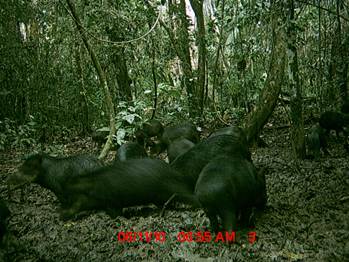 Peccaries bathe in their wallow. Photo courtesy of Harald Beck. |
Harald Beck: Overlooked is probably an understatement, considering that neither government agencies nor conservation organizations barely focus on peccary research or conservation action plans. Charismatic species, such as panda or jaguar, are elevated to an umbrella or flagship species because they are much more attractive for politicians, researchers, and grant agencies. I believe that conservation efforts should be guided by ecological criteria rather than marketing strategies. We should focus on species that have the largest number of non-redundant (unique!) ecological roles and myriad species interactions.
For instance, it appears that jaguars can survive in much smaller forest fragments than white-lipped peccaries or tapirs. Yet jaguars are, by many, considered an “umbrella or flagship species”, meaning that if they persist in a given forest, many other species will too. In a world with very limited funding and an increase in ecological emergencies, new holistic strategies should be developed.
HOW PECCARIES AID FROGS
Mongabay: Wait a second, peccaries help frogs?!
Harald Beck: Well as it turns out it is more than just frogs—a list of animals that utilize wallows include various insects (e.g. beetles, dragonflies), spiders, mussels, frogs, fishes (photo), snakes (photo), and even bats (photo).
Mongabay: What is an ecosystem engineer?
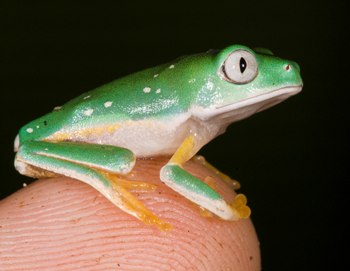 A tree frog found utilizing a peccary wallow. Photo courtesy of Harald Beck. |
Harald Beck: The concept of “Ecosystem Engineer” was first proposed by Clive Jones and his colleagues in 1994. After an initial resistance, it is now widely accepted within ecology. This concept and its recent extensions have tremendously contributed to biology and conservation. They allow researchers to discover and quantify unique species interactions and ecosystem functions that were not captured with other concepts such as theoretical food web approaches or energy flow models.
In a nutshell, ecosystem engineers are species that physically create or modify existing environments, thereby changing the availability of resources for other species. These environmental changes can have both positive and negative ecological consequences, for instance, affecting the abundance or diversity of sympatric species (i.e. living in the same area). On a larger landscape level, however, most studies found positive effects.
Everybody knows at least one species that functions as ecosystem engineer: us—we, humans, are the “master” in changing the environment. Every time a tropical rainforest is converted into a highway, we can see the immediate negative effects on species abundance and diversity. Classic examples of ecosystem engineers are beavers and corals. Beavers dam streams to fit their ecological requirements, including escaping from predators or storage of food. These newly created beaver ponds and wetlands will be soon colonized by a new suite of plant and animal species that have not been found in this area before. If we zoom out, we will find not only the original species along the river, but now additional species, resulting in an increase in species diversity.
It has been estimated that over 500,000 species depend on coral reefs—structures that are engineered by tiny corals. So the positive effects of ecosystem engineers become pretty obvious. The thought that over 25% of total coral reefs have already disappeared and two-thirds of those remaining are highly threatened is really scary and devastating.
Mongabay: You recently studied whether or not peccaries are ‘ecosystem engineers’ for frogs. What service do they provide?
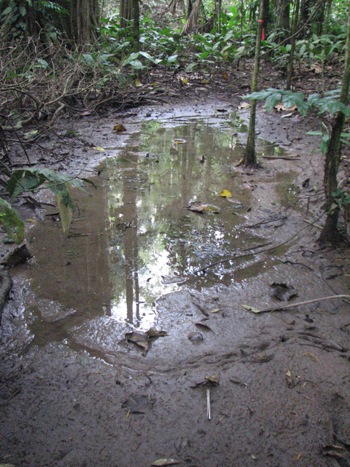 Large wallow created by peccaries provides habitat for a wide variety of species. Photo courtesy of Harald Beck. |
Harald Beck: At the Cocha Cashu field station in the Manu National Park, my students and I tested if peccaries were ecosystem engineers by creating and maintaining wallows, water filled depressions in the forest floor that typically range from 1 to over 50 square meters (photo). Peccaries may use wallows to cool down and to reduce the parasite load, or just because it is fun to splash in water and roll around in mud.
Interestingly, the oldest wallow is over 17 years old! This means that numerous generations of peccaries use the same wallows and pass their locations on to the next generation. Over time wallows become larger and deeper as peccaries compact the soil and widen the edge. Wallows can be easily distinguished from natural ponds by signs of peccary wallowing activities, such as footprints or mud spray on the surrounding vegetation. Because of their trampling, no plants or even leaf litter are on the floor (photo). In most rainforests during the dry season, standing water bodies are scarce on the forest floor, therefore peccary wallows could be critical aquatic habitat and breeding sites for insect and frog species.
Mongabay: What were the findings of your study?
Harald Beck: We found no significant differences in any physical (e.g. temperature) and chemical (e.g. pH, nitrogen) water parameters between wallows and ponds. These results were promising because if, for example, wallows had only very little amount of dissolved oxygen or had very acidic water, it could prevent certain species from using them.
Wallows had consistently higher water surface area than naturally occurring ponds. This is also critical because it means that wallows are more stable and predictable habitats than ponds. So given the choice of laying eggs in a stable wallow or soon dried up pond, where would you go? With that in mind, it was not too surprising that wallows had a significantly higher density of tadpoles, metamorphs (“tadpoles” with legs and ready to conquer the land), and adult frogs. Furthermore, more species of all three frog life stages occurred in wallows than they did in ponds.
We also found other species in wallows, including numerous aquatic insects (e.g. beetles, dragonflies, mosquito larvae, and even a semi-aquatic cricket!), and spiders that glide across the water surface and hunt prey. We also found mussels, at least nine different species of fish, and two species of snakes. This year we installed motion-triggered cameras and captured bats skimming across the water surface.
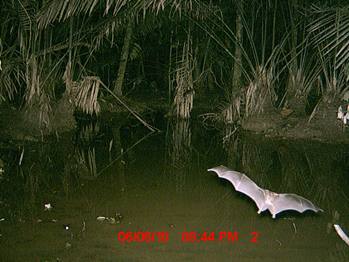 Motion-triggered camera captures a bat skimming a wallow for prey. Photo courtesy of Harald Beck. |
Now I am interested in investigating the interactions of this still growing wallow community. For example, tadpoles can be critical prey items for dragonfly larvae and some fish species. Wallow communities are species rich microcosms, with myriad interactions that are made possible by the engineering behavior of peccaries.
Mongabay: What other ecosystem engineer role do peccaries play?
Harald Beck: Peccaries frequently forage for seeds and insects by bulldozing through the understory. These not only result in the destruction of many seedlings and herbaceous plants, but also leave patches of the forest floor without leaf litter. These patches of bare soil could be critical germination sites for some small-seeded plant species for which leaf litter is either a physical or chemical barrier and prevents germination. Using various experiments, I tested if leaf litter-free sites promoted the establishment of certain species and whether peccaries affected the forest plant community by engineering seed germination sites.
PECCARIES AND SEEDS
Mongabay: What role do peccaries play in seed dispersal? Would you characterize them as more destructive or productive?
Harald Beck: This is a very interesting and ecologically critical question and I wrote several reviews (2005 and 2006) and research papers (2007 and 2010) on this topic. Meanwhile a small group of very dedicated peccary biologists has published additional papers. Overall it appears that peccaries consume fruits of around 250 plant species and destroy the seeds of over 150 species (to put this in perspective: just name your 25 most favorite fruits)! These are two world records and no other tropical mammal even comes close to these numbers.
But what does that mean in the big picture? Well! Clearly peccaries play an ecologically critical role as seed predator by being able to prey on small seeds (e.g. Ficus) to very hard seeds (e.g. Mauritius palm). Peccaries prevent common plant species from taking over and outcompeting rare species. This is known as “Preventing Competitive Exclusion”, a huge concept in biology that is thought to maintain tropical species diversity.
At the same time my research indicated that around 50 plant species were successfully dispersed by peccary. Seeds either survived the trip through the digestive system or traveled by attaching to their fur (well that is where the “velcro idea” originated from) and fell off at a random point in time. Research (by John Terborgh and colleagues) has unequivocally documented that peccaries play critical non-redundant roles (no other species could substitute their roles) as seed predators and dispersers, meaning that in forests where peccaries have become extinct, the plant species composition changed dramatically.
Mongabay: How many plant and animal species to date have been linked to peccaries?
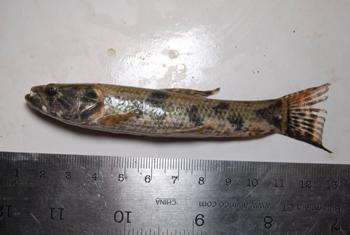 A tiger tetra (Hoplias malabaricus) found in a peccary wallow. Photo courtesy of Harald Beck. |
Harald Beck: That is a question nobody really knows and we clearly need more funding to conduct additional research. As herds of peccaries trample and bulldoze through the understory, the large number of plants (including tree seedlings and herbaceous species) are destroyed. Furthermore, peccaries consume seeds of over 150 species while, at the same time, dispersing at least 50 species. I am not aware of any Neotropical mammal species that have more plant species interactions!
Our research indicated that at least 10 frog species depended on wallows as foraging and breeding habitat. We just started to quantify the role of wallow habitats for invertebrate, turtle, and fish species. Our preliminary data suggests that several, in particular less mobile, species are tightly linked to wallows and their fate depends on the presence of peccaries.
Mongabay: How might forests change if peccary populations continue to decline?
Harald Beck: Peccaries consume and disperse seeds of over 200 plant species and trample many other species. These interactions dramatically affect the recruitment, spatial distribution, and the species composition of the forest plant community. In an earlier study, just focusing on a one single plant species, I found that in forests where peccaries were extinct, the seedling density of Iriartea palm increased by almost 500% compared to forests where peccaries were still roaming freely.
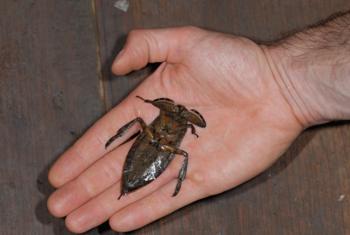 An giant water bug found in a peccary wallow. Photo courtesy of Harald Beck. |
So, now imagine a forest without peccaries and considering all those interactions …. Plant species that are used to experiencing seed predation will increase in density while species that are no longer dispersed may experience a decline. And yes, frog and other species that depend on peccary wallows go extinct. With their myriad ecological services and interactions, peccaries maintain biodiversity and ecosystem integrity.
Both research in “empty forests” (extinction of large mammal, bird, and reptile species) and research conducted in forests without the “mammalian megafauna” (peccaries and tapir) confirmed, over and over again, dramatic changes in the forest plant communities. Much less is known about the trophic cascading effects to other groups, such as animals and mycorrhizae (colonizing fungus). One study found that in forests where peccaries were extinct and wallows were no longer maintained, several frog species died off quickly too.
THREATS TO PECCARIES
Mongabay: What is threatening peccaries?
Harald Beck: Together with Dr. Mariana Altrichter (University of Redlands, California), I am co-chairing the IUCN Peccary Specialist Group. This very active group has complied detailed information on the distribution and threat of all three peccary species (http://www.iucnredlist.org/apps/redlist/search).
The experts identified that hunting and habitat destruction were the most severe threats to peccary populations throughout the Neotropics. Besides hunting and habitat destruction, we are also worried about human’s encroachments into rainforests and the potential threats of disease transmission from livestock that could wipe out whole populations of peccaries.
Mongabay: Are peccaries protected anywhere?
Harald Beck: Chacoan peccaries are included in Appendix I of the Convention on International Trade in Endangered Species [CITES] (i.e. international trade is prohibited) and listed as Endangered by the IUCN. Every country has its own hunting regulations, for example, hunting of any wildlife is prohibited in Paraguay and Brazil, and the Chacoan peccary is officially protected in Argentina. However, studies documented that Chacoan peccaries were heavily hunted across their range. The existing hunting regulations are widely ignored or not enforced.
White-lipped peccaries are included in Appendix II of the CITES (i.e. international trade is permitted) and listed as Near Threatened by the IUCN. Sadly white-lipped peccaries are extinct in large parts of Central America and El Salvador. Within the last century, the range of white-lipped peccaries has been reduced by over 21%. The species is judged to have a high probability of long-term survival in only 47% of its current distribution.
Collared peccaries are placed on Appendix II of CITES and the IUCN listed them as Least Concern, meaning that given the continuing rates of habitat loss and potential overhunting, the status of all populations requires monitoring. For example, there is a total ban on all hunting of peccaries by non-indigenous people in Brazil, though this is not enforced in many states.
Subsistence hunting is permitted in Colombia and Venezuela, whereas in Peru both subsistence hunting and international trade of peccary products are allowed and regulated by laws.
Mongabay: What is the most endangered peccary species? Why?
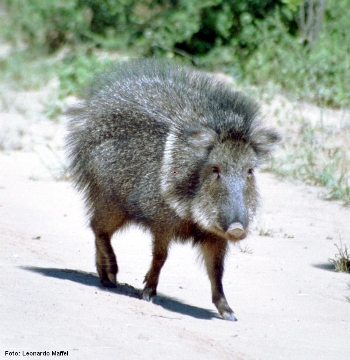 World’s most threatened peccary: the chacoan. Photo by: Leonardo Maffei. |
Harald Beck: Chacoan peccaries are the most endangered species. This species is endemic to the dry Chaco of western Paraguay, south-eastern Bolivia, and northern Argentina, thus it has the smallest geographical distribution when compared to the other two peccary species. Continuing habitat destruction and relentless hunting will most likely wipe out most of the already heavily fragmented populations.
White-lipped peccaries are the second most endangered peccary species because they require large continuous forests to support their large herds. As it is true for all peccary species, white-lipped peccaries are relative “easy game species”, hunting with dogs and firearms can wipe out family units or even whole herds.
Collared peccaries seem to be able to cope best with human disturbances, yet they also experienced local extinctions. Their smaller family units require less continuous forests than do white-lipped peccaries. They can utilize a wider range of habitats, including land degraded by humans.
Mongabay: A new species of peccary, the giant peccary, was proposed in 2007, but questions remain as to whether or not it is a distinct species. What is your view?
Harald Beck: Considering the vast Neotropical rainforest, it is not surprising. There could be more than three peccary species. The recent announcement of a new “giant peccary” (“Pecari maximus”) species from Brazil is exciting but clearly preliminary. The species description was based on insufficient samples, which did not permit an adequate comparison with sympatrically occurring peccary species. Most taxonomists, geneticists, and peccary specialists agree that much more morphological, genetic, and ecological data are required to unequivocally describe a new species. Therefore, the IUCN Species Survival Commission has not accepted “Pecari maximus” as a new species and the validity of this species needs further testing.
Mongabay: Is there evidence that links local peccary extinction to the loss of frogs?
Harald Beck: Yes, there is. At least two studies have found that once peccaries went locally extinct, several frog species that required wallows as foraging and breeding habitat also went extinct (see also answer above).
Mongabay: What other species are likely impacted when peccaries go extinct locally?
Harald Beck: As mentioned above, considering that peccaries consume and disperse fruits and seeds from over 400 plant species and trample many seedlings, their impact is huge. Not surprisingly, there are many studies documenting changes in the plant species distribution and plant community in forests without peccaries.
Mongabay: Given their ecological importance how do we save abundant populations of peccaries?
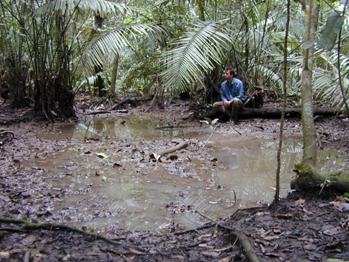 Dr. Beck at a medium sized peccary wallow. Photo courtesy of Harald Beck. |
Harald Beck: This and other similar questions are currently assessed by the newly formed IUCN Peccary Specialist Group. We have approximately 40 members from 16 different countries, including researchers from many different biological disciplines, veterinarians, zoo experts, and conservation organizations.
I believe that we need to raise awareness of the “Peccary Dilemma” by conveying ecological information much more effectively to the general public, policy-makers, and resource managers. We need to develop partnerships with the media, governmental agencies, NGOs, and private foundations to secure sufficient resources and develop realistic conservation strategies.
Clearly, habitat destruction and hunting are the main threats to peccaries and other Neotropical species. The establishment of new and sufficient financial and logistic support for existing national parks is critical. There are too many “Paper parks”, which function more like hunting resorts without enforcing existing laws. Connecting corridors between forest fragments might ensure dispersal and re-colonization; thus, promoting genetic diversity across fragmented landscapes.
On a global scale what worries most ecologists is global warming and its resulting changes in weather patterns that will affect even the very best protected national parks. Human population explosion and the ever increasing demand for resourses and land will further destroy habitats and their inhabitants. It is easy from the comfort zone of my air-conditioned office to say, “let’s protect peccaries,” while a hungry campesino is hunting to feed his family. There is a lot of work ahead of us if we really want to share tropical diversity with our children.
¡Vamos Amigos!
For more information on Dr. Beck’s research and publications, please visit: http://towson.academia.edu/HaraldBeck
Peccary herd uses one of its wallows. Video courtesy of Harald Beck.
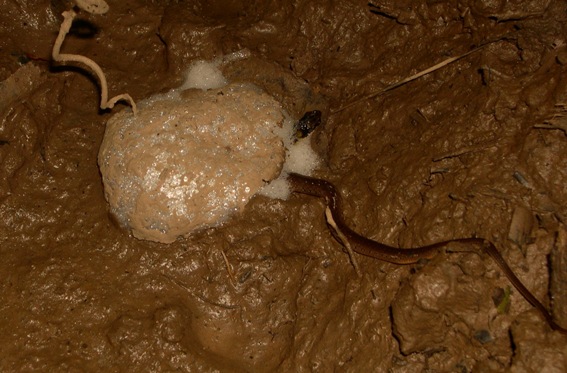
Snake feeds on tadpoles–hiding in the foam–at a peccary wallow. Photo courtesy of Harald Beck.
Students with Towson University measure the size of a peccary wallow. Photo courtesy of Harald Beck.
Peccaries visit wallow during the day. Photo courtesy of Harald Beck.
Related articles
New peccary species discovered by embattled Amazon scientist
(11/04/2007) A new species of peccary has been discovered in the Amazon rainforest by a scientist recently charged with biopiracy by the Brazilian government.
(08/05/2010) If you have been fortunate enough to visit the Amazon or any other great rainforest, you’ve probably been wowed by the multitude and diversity of life. However, you also likely quickly realized that the deep jungle is not quite what you may have imagined when you were a child: you don’t watch as jaguars wrestle with giant anteaters or anacondas circle prey. Instead life in the Amazon is small: insects, birds, frogs. Even biologists will tell you that you can spend years in the Amazon and never see a single jaguar. Yet rainforest guide and modern day explorer Paul Rosolie says there is another Amazon, one so pristine and with such wild abundance that it seems impossible to imagine if not for Rosolie’s stories, photos, and soon videos. This is an Amazon where the big animals—jaguars, tapir, anaconda, giant anteaters, and harpy eagles—are not only abundant but visible. Free from human impact and overhunting, these remote places—off the beaten path of tourists—are growing ever smaller and, according to Rosolie, are in danger of disappearing forever.
Oil road transforms indigenous nomadic hunters into commercial poachers in the Ecuadorian Amazon
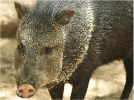
(09/13/2009) The documentary Crude opened this weekend in New York, while the film shows the direct impact of the oil industry on indigenous groups a new study proves that the presence of oil companies can have subtler, but still major impacts, on indigenous groups and the ecosystems in which they live. In Ecuador’s Yasuni National Park—comprising 982,000 hectares of what the researchers call “one of the most species diverse forests in the world”—the presence of an oil company has disrupted the lives of the Waorani and the Kichwa peoples, and the rich abundance of wildlife living within the forest.
Conservation of Mexico’s ungulate species explored
(05/25/2009) Nearly one third of the New World’s 32 species of ungulates are found in Mexico, which serves as an important biological transition zone between temperate North America and tropical Central and South America. While few of these species are at risk of extinction, their ecological and economic importance makes them a significant conservation concern. As such, a special issue of Tropical Conservation Science, mongabay.com’s open access journal, takes a closer look at Mexico’s ungulates.
Camera trap photos reveal bushmeat hunting threat to jaguars in Ecuador
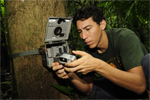
(01/27/2009) Jaguars are the largest cats of the Americas and third largest cats in the world. The primary rainforest in the Amazon region of Ecuador is among their last remaining strongholds. Jaguars are listed as “vulnerable” in Ecuador, and Santiago Espinosa, Wildlife Conservation Society (WCS) fellow, PhD candidate from University of Florida/Gainesville, and WWF fellow, wants to know just how many jaguars are left in his home country. He is developing strategies to protect them by determining their numbers and the factors that threaten them through a unique method of non-invasive photography.
Wildlife trade creating “empty forest syndrome” across the globe
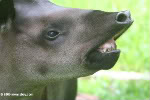
(01/19/2009) For many endangered species it is not the lack of suitable habitat that has imperiled them, but hunting. In a talk at a Smithsonian Symposium on tropical forests, Elizabeth Bennett of the Wildlife Conservation Society (WCS) outlined the perils for many species of the booming and illegal wildlife trade. She described pristine forests, which although providing perfect habitat for species, stood empty and quiet, drained by hunting for bushmeat, traditional medicine, the pet trade, and trophies.
